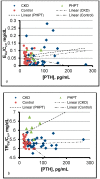Tradeoff-in-the-Nephron: A Theory to Explain the Primacy of Phosphate in the Pathogenesis of Secondary Hyperparathyroidism
- PMID: 28445401
- PMCID: PMC5452157
- DOI: 10.3390/nu9050427
Tradeoff-in-the-Nephron: A Theory to Explain the Primacy of Phosphate in the Pathogenesis of Secondary Hyperparathyroidism
Abstract
Chronic kidney disease (CKD) causes secondary hyperparathyroidism (SHPT). The cardinal features of SHPT are persistence of normocalcemia as CKD progresses and dependence of the parathyroid hormone concentration ([PTH]) on phosphate influx (IP). The tradeoff-in-the-nephron hypothesis integrates these features. It states that as the glomerular filtration rate (GFR) falls, the phosphate concentration ([P]CDN) rises in the cortical distal nephron, the calcium concentration ([Ca]CDN) in that segment falls, and [PTH] rises to maintain normal calcium reabsorption per volume of filtrate (TRCa/GFR). In a clinical study, we set GFR equal to creatinine clearance (Ccr) and IP equal to the urinary excretion rate of phosphorus (EP). We employed EP/Ccr as a surrogate for [P]CDN. We showed that TRCa/Ccr was high in patients with primary hyperparathyroidism (PHPT) and normal in those with SHPT despite comparably increased [PTH] in each group. In subjects with SHPT, we examined regressions of [PTH] on EP/Ccr before and after treatment with sevelamer carbonate or a placebo. All regressions were significant, and ∆[PTH] correlated with ∆EP/Ccr in each treatment cohort. We concluded that [P]CDN determines [PTH] in CKD. This inference explains the cardinal features of SHPT, much of the evidence on which other pathogenic theories are based, and many ancillary observations.
Keywords: calcium; chronic kidney disease; cortical distal nephron; distal convoluted tubule; parathyroid hormone; phosphate; secondary hyperparathyroidism.
Conflict of interest statement
The author declares no conflict of interest.
Figures


Similar articles
-
Chemical evidence for the tradeoff-in-the-nephron hypothesis to explain secondary hyperparathyroidism.PLoS One. 2022 Aug 1;17(8):e0272380. doi: 10.1371/journal.pone.0272380. eCollection 2022. PLoS One. 2022. PMID: 35913960 Free PMC article.
-
Use of sevelamer to examine the role of intraluminal phosphate in the pathogenesis of secondary hyperparathyroidism.Clin Nephrol. 2014 Sep;82(3):191-201. doi: 10.5414/cn108227. Clin Nephrol. 2014. PMID: 25079864 Clinical Trial.
-
An examination of multiple explanations for secondary hyperparathyroidism .Clin Nephrol. 2020 Aug;94(2):70-77. doi: 10.5414/CN110043. Clin Nephrol. 2020. PMID: 32567541
-
Cinacalcet HCl: a novel treatment for secondary hyperparathyroidism caused by chronic kidney disease.J Ren Nutr. 2006 Jul;16(3):253-8. doi: 10.1053/j.jrn.2006.04.010. J Ren Nutr. 2006. PMID: 16825031 Review.
-
1alpha(OH)D3 One-alpha-hydroxy-cholecalciferol--an active vitamin D analog. Clinical studies on prophylaxis and treatment of secondary hyperparathyroidism in uremic patients on chronic dialysis.Dan Med Bull. 2008 Nov;55(4):186-210. Dan Med Bull. 2008. PMID: 19232159 Review.
Cited by
-
Mediation of the relationship between proteinuria and serum phosphate: Insight from the KNOW-CKD study.PLoS One. 2020 Jun 22;15(6):e0235077. doi: 10.1371/journal.pone.0235077. eCollection 2020. PLoS One. 2020. PMID: 32569271 Free PMC article.
-
Chemical evidence for the tradeoff-in-the-nephron hypothesis to explain secondary hyperparathyroidism.PLoS One. 2022 Aug 1;17(8):e0272380. doi: 10.1371/journal.pone.0272380. eCollection 2022. PLoS One. 2022. PMID: 35913960 Free PMC article.
-
Association of serum calcium levels with diabetic kidney disease in normocalcemic type 2 diabetes patients: a cross-sectional study.Sci Rep. 2024 Sep 14;14(1):21513. doi: 10.1038/s41598-024-72747-8. Sci Rep. 2024. PMID: 39277673 Free PMC article.
References
-
- Levin A., Bakris G.L., Molitch M., Smulders M., Tian J., Williams L.A., Andress D.L. Prevalence of abnormal serum vitamin D, PTH, calcium and phosphorus in patients with chronic kidney disease: Results of the study to evaluate early kidney disease. Kidney Int. 2007;71:31–38. doi: 10.1038/sj.ki.5002009. - DOI - PubMed
-
- Craver L., Marco M.P., Martinez I., Rue M., Borras M., Martin M.L., Sarro F., Valdivielso J.M., Fernandez E. Mineral metabolism parameters throughout chronic kidney disease stages 1–5—Achievement of K/DOQI target ranges. Nephrol. Dial. Transplant. 2007;22:1171–1176. doi: 10.1093/ndt/gfl718. - DOI - PubMed
MeSH terms
Substances
LinkOut - more resources
Full Text Sources
Other Literature Sources

